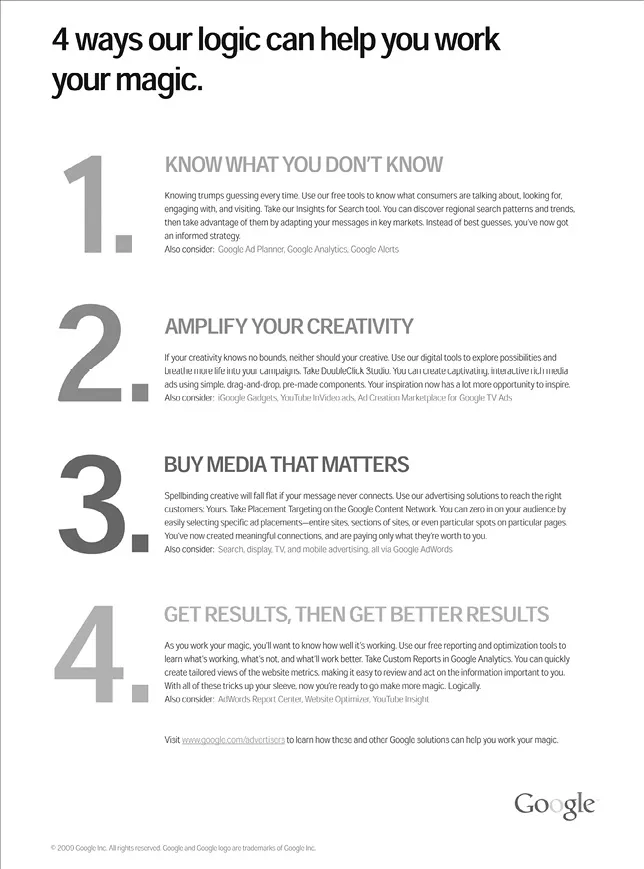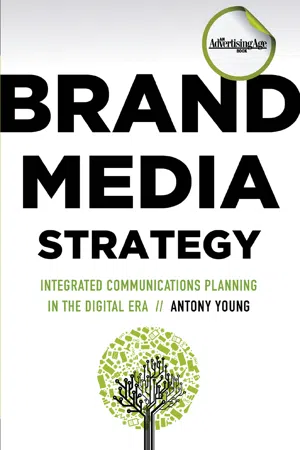Chapter 1
Google and Facebook
How They’re Changing the Game
Google and Facebook and a host of other digital media have disrupted the marketing communications profession. The two companies, each in its own unique way, have changed the game. While it is tempting to dismiss popular digital fads, the impact of Google and Facebook goes way beyond their respective numbers of visitors or valuations. They have reshaped mass communications globally and opened up opportunities for marketers to execute more accountable, influential, and multidimensional campaigns.
Branding has been the foundation of the advertising industry for a century. Broadcast and print advertising’s forte was in growing brand awareness and building brands. In some respects, digital media has set higher standards, in effect repositioning the industry’s perspective of established media, because digital media enables consumer response measurement. Tracking and optimization tools for digital media provide granular and near real-time response to creative messaging, which allows not just a higher degree of accountability but more sophistication in influencing buyer behavior.
Digital media also provides a level of interactivity that by its very nature enables a more personalized experience. Users are able to get information how and when they want it. The Internet has become the information medium of choice and a significant factor in influencing purchase decisions. For marketers, digital media provides insight into how to reach customers and convert interest into intent to purchase.
The peer-to-peer connectivity of social media needs to become central to every marketer’s thinking. We are taking product recommendations from strangers, brand likes from friends on Facebook, or seeing our search results on Google influenced by the social media activity of people we are connected to. Marketers are adjusting for these trends. According to a 2013 survey by Dimensional Research, two-thirds of people read product reviews online, and of those, 90 percent say it influenced their shopping.1
Knowing the digital media space is vital to getting the most out of advertising. Let’s take a brief look at the two companies.
Google: The Magic, the Logic
For decades, advertising has been about creativity, art, and emotional connections. And then came Google, bringing with it an advertising era based on math, reason, and logic. Google offered to solve the age-old conundrums of marketers: waste and accountability. What marketer wouldn’t want solutions to both?
Google helped advertisers by providing the ability to directly target consumers at the moment they’re looking for a product or service. Google serves up an ad on its search site and elsewhere at the precise point in time that people are researching a potential purchase or, even better, are ready to buy online. Quite simply, Google’s AdWords program has revolutionized the way companies big and small advertise.
Google’s ability to serve as a conduit for sellers looking for customers has created billions of dollars in profitability, and few think Google’s potential is anywhere near fulfilled, such is its lock on our collective consciousness. “Google and its competitors have created the first application to leverage the database of intentions in a commercial manner: paid search,” writes John Battelle in The Search: How Google and Its Rivals Rewrote the Rules of Business and Transformed Our Culture.2 Battelle came up with the phrase “the database of intentions” to convey the power Google holds in knowing what we’re all searching for, whether it’s boots, books, doctors, or divorces. Google’s advantage comes in matching advertisers to all those searches for information. What ads web users see depends on a variety of factors, but the most important one is the ads’ relevance to the initial search phrase. “It is a very efficient marketing program,” says former Gateway online strategist Antonella Pisani. “You are capturing people while they are interested.”3
For an example of AdWords’ effectiveness, take Paul Bond Boots, an Arizona-based family-owned business that sells cowboy boots. When asked “How good of a program is Google AdWords for small business?” one of the company executives said, “In my opinion it would be indispensable at a time like this.”4 The company’s ad showed up on the right in the sponsored links section when “cowboy boots” was typed in the search box. But Google AdWords isn’t a media sales tool for just the Paul Bonds of this world. Fortune 100 companies such as CitiGroup, IBM, and even Google competitor Microsoft rely on Google’s utility and targetability for their commercial success. It’s hard to imagine Amazon as the company it is today without Google AdWords.
The change that Google has brought on advertising cannot be overstated. It forced a paradigm shift for advertisers, moving their decision-making away from targeting demographics and mass audiences to connecting with individuals in a much more relevant way. As a result, marketers have seen wastage significantly reduced. Since AdWords’ cost is based on an auction model connected to the price and effectiveness of the advertising, the onus is on the advertiser to develop more effective copy. Google’s brilliance is that advertisers can see whether a coupon or a free recipe is more effective. And even better, advertisers can adjust their plan almost instantaneously without significant additional costs, in contrast to making ad changes in traditional media, which is slow and expensive.
Advertisers can’t buy their way to the top—the ads have to be relevant to the people typing the search term, and Google ranks the site they are directed to by its quality. And that is a critical point for a marketing strategy—how well do you know customers and how well are you targeting them with the message they want to hear? How much marketers pay for their ads to be clicked on is decided by factors that Google—not the advertiser—controls. Yet Google has democratized advertising, making it accessible to small advertisers and taking away the clout and scale enjoyed by bigger fish.
Ken Auletta in his book Googled: The End of the World as We Know It observed that Google believes it is helping shape a new and better media world by making the buying of advertising more accountable and transparent. In Google’s view, the company serves consumers by offering advertising as information. And by offering a bidding system based on rewarding the more responsive ads, it is helping improve advertising performance.5
Google’s largest impact on the media business as a whole has been to force it to compare its conventional metrics with sophisticated Internet data. In an attempt to stem the flow of dollars to more accountable media, television networks agreed to move from program ratings—the currency of the industry since television ad buying began—to commercial break ratings, which made it possible to estimate how many people were viewing a particular commercial. Newspaper executives only provide circulation figures; whereas, digital advertisers know exactly who’s reading what story, when, and often where.
What’s more, consumers’ appetite for search continues to grow. In 2012, Google saw just over five billion searches a day, double the number just three years earlier.6
Google has highlighted the undeniable fact that the established advertising business was built around a soft measurement—say, ratings or readers or impressions. The increased transparency of digital advertising’s direct impact on sales and leads is pushing other media to do better. Our clients will no longer accept “estimated measures” of success when digital media provides them with hard data that can be tied directly to results.
Google ran a print ad targeted to the advertising community that (Figure 1.1), explains in very simple terms four ways the company can help marketers. In many ways that copy reflects this new era of advertising accountability that Google champions.
Google’s business has expanded to include many multiple businesses from its venture into mobile with its Android operating system, to YouTube as the number one video site, to its own social media channel in Google+, and its AdSense display advertising business, and many other ventures, experiments, and acquisitions. There’s no question of AdWords continued importance to the marketing community, as well as to Google Inc.’s business.
Facebook’s Influence of a Billion PlUS Friends
The number of social media sites is exploding, and usage is up in almost every dimension—as good a reason as any for marketers to take note.
Launched by Mark Zuckerberg in 2004 from his Harvard University dorm, Facebook began life as a site to help fellow students share videos and messages rather than emailing them or uploading them to clunky sites. Facebook’s simple interface, rather like Google’s simple home page, is one reason its popularity leapfrogged other earlier sites such as MySpace and Friendster.
Its number of users exceeded a billion in the summer of 2012. But it is its utility that has led to its becoming so influential. According to Facebook, half of all users access the site each day, and on average they spend 8.3 hours on the site each month. It remains the largest site where photos are shared. In addition, some 7.5 million websites have a Facebook share button on them.7
Its impact on world events has been huge. Suddenly the power of word of mouth, networks, and small groups has become magnified globally.
When a new disaster strikes in the world, social media sites, such as Facebook and Twitter, are increasingly the places that people turn to first to find out what happened from friends or witnesses who are reporting before the news media. The Arab Spring rising in Egypt in 2011 saw Facebook play a role in mobilizing communities, as did the managing of relief efforts for Haiti. The New York-based Haitian Times wrote that “the use of social networks as a major way of communications is a first for Haitians, who have traditionally relied on radio and word of mouth as the best source of information.”8
David Kirkpatrick writes that Zuckerberg and others at Facebook “believe [that] more visibility makes us better people. Some claim, for example, that because of Facebook, young people today have a harder time cheating on their boyfriends ...


